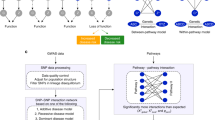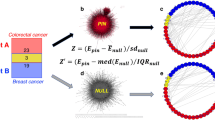Abstract
Genetic interaction analysis,in which two mutations have a combined effect not exhibited by either mutation alone, is a powerful and widespread tool for establishing functional linkages between genes. In the yeast Saccharomyces cerevisiae, ongoing screens have generated >4,800 such genetic interaction data. We demonstrate that by combining these data with information on protein-protein, prote in-DNA or metabolic networks, it is possible to uncover physical mechanisms behind many of the observed genetic effects. Using a probabilistic model, we found that 1,922 genetic interactions are significantly associated with either between- or within-pathway explanations encoded in the physical networks, covering ∼40% of known genetic interactions. These models predict new functions for 343 proteins and suggest that between-pathway explanations are better than within-pathway explanations at interpreting genetic interactions identified in systematic screens. This study provides a road map for how genetic and physical interactions can be integrated to reveal pathway organization and function.
This is a preview of subscription content, access via your institution
Access options
Subscribe to this journal
Receive 12 print issues and online access
$209.00 per year
only $17.42 per issue
Buy this article
- Purchase on Springer Link
- Instant access to full article PDF
Prices may be subject to local taxes which are calculated during checkout





Similar content being viewed by others
References
Guarente, L. Synthetic enhancement in gene interaction: a genetic tool come of age. Trends Genet. 9, 362–366 (1993).
Avery, L. & Wasserman, S. Ordering gene function: the interpretation of epistasis in regulatory hierarchies. Trends Genet. 8, 312–316 (1992).
Thomas, J.H. Thinking about genetic redundancy. Trends Genet. 9, 395–399 (1993).
Hartman, J.L., Garvik, B. & Hartwell, L. Principles for the buffering of genetic variation. Science 291, 1001–1004 (2001).
Sham, P. Shifting paradigms in gene-mapping methodology for complex traits. Pharmacogenomics 2, 195–202 (2001).
Dolma, S., Lessnick, S.L., Hahn, W.C. & Stockwell, B.R. Identification of genotype-selective antitumor agents using synthetic lethal chemical screening in engineered human tumor cells. Cancer Cell 3, 285–296 (2003).
Forsburg, S.L. The art and design of genetic screens: yeast. Nat. Rev. Genet. 2, 659–668 (2001).
Tong, A.H. et al. Systematic genetic analysis with ordered arrays of yeast deletion mutants. Science 294, 2364–2368 (2001).
Ooi, S.L., Shoemaker, D.D. & Boeke, J.D. DNA helicase gene interaction network defined using synthetic lethality analyzed by microarray. Nat. Genet. 35, 277–286 (2003).
Tong, A.H. et al. Global mapping of the yeast genetic interaction network. Science 303, 808–813 (2004).
Li, S. et al. A map of the interactome network of the metazoan C. elegans. Science 303, 540–543 (2004).
Rain, J.C. et al. The protein-protein interaction map of Helicobacter pylori. Nature 409, 211–215 (2001).
Uetz, P. et al. A comprehensive analysis of protein-protein interactions in Saccharomyces cerevisiae. Nature 403, 623–627 (2000).
Giot, L. et al. A protein interaction map of Drosophila melanogaster. Science 302, 1727–1736 (2003).
Ito, T. et al. Toward a protein-protein interaction map of the budding yeast: a comprehensive system to examine two-hybrid interactions in all possible combinations between the yeast proteins. Proc. Natl. Acad. Sci. USA 97, 1143–1147 (2000).
Ho, Y. et al. Systematic identification of protein complexes in Saccharomyces cerevisiae by mass spectrometry. Nature 415, 180–183 (2002).
Gavin, A-C., Bösche, M., Krause, R., Grandi, P. & Marzioch, M. Functional organization of the yeast proteome by systematic analysis of protein complexes. Nature 415, 141–147 (2002).
Lee, T.I. et al. Transcriptional regulatory networks in Saccharomyces cerevisiae. Science 298, 799–804 (2002).
Harbison, C.T. et al. Transcriptional regulatory code of a eukaryotic genome. Nature 431, 99–104 (2004).
Ozier, O., Amin, N. & Ideker, T. Global architecture of genetic interactions on the protein network. Nat. Biotechnol. 21, 490–491 (2003).
Tucker, C.L. & Fields, S. Lethal combinations. Nat. Genet. 35, 204–205 (2003).
Winzeler, E.A. et al. Functional characterization of the S. cerevisiae genome by gene deletion and parallel analysis. Science 285, 901–906 (1999).
Mewes, H.W. et al. MIPS: a database for genomes and protein sequences. Nucleic Acids Res. 30, 31–34 (2002).
Xenarios, I. et al. DIP, the Database of Interacting Proteins: a research tool for studying cellular networks of protein interactions. Nucleic Acids Res. 30, 303–305 (2002).
Kanehisa, M., Goto, S., Kawashima, S. & Nakaya, A. The KEGG databases at GenomeNet. Nucleic Acids Res. 30, 42–46 (2002).
Shannon, P. et al. Cytoscape: a software environment for integrated models of biomolecular interaction networks. Genome Res. 13, 2498–2504 (2003).
Gene Ontology Consortium. Creating the gene ontology resource: design and implementation. Genome Res. 11, 1425–1433 (2001).
Zar, J.H. Biostatistical Analysis, edn. 3 (Prentice Hall, New Jersey, 1996).
Kendall, S.M., Stuart, A. & Ord, J.K. Kendall's Advanced Theory of Statistics, edn. 5 (Oxford University Press, NY, 1987).
Milo, R. et al. Network motifs: simple building blocks of complex networks. Science 298, 824–827 (2002).
Geissler, S., Siegers, K. & Schiebel, E. A novel protein complex promoting formation of functional alpha- and gamma-tubulin. EMBO J. 17, 952–966 (1998).
Kahana, J.A. et al. The yeast dynactin complex is involved in partitioning the mitotic spindle between mother and daughter cells during anaphase B. Mol. Biol. Cell 9, 1741–1756 (1998).
Pidoux, A.L. & Allshire, R.C. Centromeres: getting a grip of chromosomes. Curr. Opin. Cell Biol. 12, 308–319 (2000).
Pfeffer, S.R. Membrane transport: retromer to the rescue. Curr. Biol. 11, R109–R111 (2001).
Siniossoglou, S., Peak-Chew, S.Y. & Pelham, H.R. Ric1p and Rgp1p form a complex that catalyses nucleotide exchange on Ypt6p. EMBO J. 19, 4885–4894 (2000).
Hwang, W.W. et al. A conserved RING finger protein required for histone H2B monoubiquitination and cell size control. Mol. Cell 11, 261–266 (2003).
Sharan, R., Ideker, T., Kelley, B.P., Shamir, R. & Karp, R.M. Identification of protein complexes by comparative analysis of yeast and bacterial protein interaction data. Proceedings of the Eighth Annual International Conference on Research in Computational Molecular Biology–RECOMB, 282–289 (ACM Press, New York, 2004)
Acknowledgements
We thank Jonathan Wang, Owen Ozier and Gopal Ramachandran for preliminary investigations and Vineet Bafna, Ben Raphael and Vikas Bansal for insightful commentary. Craig Mak, Silpa Suthram and Taylor Sittler provided helpful reviews of the text. Funding was provided by the National Institute of General Medical Sciences (GM070743-01) and the National Science Foundation (NSF 0425926).
Author information
Authors and Affiliations
Corresponding author
Ethics declarations
Competing interests
The authors declare no competing financial interests.
Supplementary information
Supplementary Fig. 1
Direct overlaps between genetic and physical interactions, while statistically significant, are limited in systematic data and probably biased. (PDF 192 kb)
Supplementary Fig. 2
Influence of beta on result set. (PDF 179 kb)
Supplementary Fig. 3
Estimated prediction accuracy for naive and pathway-based within-pathway genetic predictions. (PDF 188 kb)
Supplementary Table 1
Compounds excluded from the physical interaction network (not used to connect two proteins in a metabolic interaction). (PDF 19 kb)
Supplementary Table 2
The members of pathways identified in various searches. (PDF 68 kb)
Supplementary Table 3
The log-odds score associated with each network model identified in various searches. (PDF 62 kb)
Supplementary Table 4
Results from reduced searches. (PDF 28 kb)
Supplementary Table 5
Functional enrichment. (PDF 23 kb)
Supplementary Table 6
GO annotation predictions made with pathways obtained from various searches. (PDF 112 kb)
Supplementary Table 7
Basis of annotation predictions. (PDF 21 kb)
Rights and permissions
About this article
Cite this article
Kelley, R., Ideker, T. Systematic interpretation of genetic interactions using protein networks. Nat Biotechnol 23, 561–566 (2005). https://doi.org/10.1038/nbt1096
Published:
Issue Date:
DOI: https://doi.org/10.1038/nbt1096
This article is cited by
-
Cytoplasmic ERα and NFκB Promote Cell Survival in Mouse Mammary Cancer Cell Lines
Hormones and Cancer (2020)
-
Association of combined genetic variations in SOD3, GPX3, PON1, and GSTT1 with hypertension and severity of coronary artery disease
Heart and Vessels (2020)
-
The translational network for metabolic disease – from protein interaction to disease co-occurrence
BMC Bioinformatics (2019)
-
Discovering genetic interactions bridging pathways in genome-wide association studies
Nature Communications (2019)
-
Bayesian network model for identification of pathways by integrating protein interaction with genetic interaction data
BMC Systems Biology (2017)



